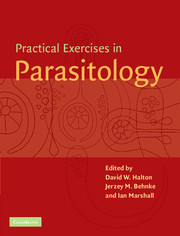Book contents
- Frontmatter
- Contents
- List of contributors
- Preface
- General advice
- 1 Observational Exercises on Parasites
- 2 Ecology
- 3 Physiology and Biochemistry
- 3.1 Hatching in vitro of oncospheres/hexacanth larvae of Hymenolepis diminuta
- 3.2 Activation of the cysticercoids of Hymenolepis species in vitro
- 3.3 Membrane transport in the cestode Hymenolepis diminuta, in vitro
- 3.4 Glycogen utilisation and deposition in flatworm parasites
- 3.5 Effects of classical transmitters on the motility of parasitic roundworms and flatworms
- 3.6 Electrophysiology of Ascaris suum body muscle
- 3.7 Immunocytochemical localisation of neuroactive substances in helminth parasites
- 4 Pathology and Immunology
- 5 Chemotherapy
- 6 Molecular Parasitology
- 7 Behaviour
- Appendix 1 Reagent index
- Appendix 2 UK suppliers
- Appendix 3 US suppliers
- Index
3.5 - Effects of classical transmitters on the motility of parasitic roundworms and flatworms
Published online by Cambridge University Press: 05 June 2012
- Frontmatter
- Contents
- List of contributors
- Preface
- General advice
- 1 Observational Exercises on Parasites
- 2 Ecology
- 3 Physiology and Biochemistry
- 3.1 Hatching in vitro of oncospheres/hexacanth larvae of Hymenolepis diminuta
- 3.2 Activation of the cysticercoids of Hymenolepis species in vitro
- 3.3 Membrane transport in the cestode Hymenolepis diminuta, in vitro
- 3.4 Glycogen utilisation and deposition in flatworm parasites
- 3.5 Effects of classical transmitters on the motility of parasitic roundworms and flatworms
- 3.6 Electrophysiology of Ascaris suum body muscle
- 3.7 Immunocytochemical localisation of neuroactive substances in helminth parasites
- 4 Pathology and Immunology
- 5 Chemotherapy
- 6 Molecular Parasitology
- 7 Behaviour
- Appendix 1 Reagent index
- Appendix 2 UK suppliers
- Appendix 3 US suppliers
- Index
Summary
Aims and objectives
This exercise is designed to demonstrate:
The physiological effects of classical transmitter substances on the motor activity of roundworm (nematode) parasite somatic musculature.
The physiological effects of classical transmitter substances on the motor activity of flatworm (platyhelminth) parasite somatic musculature.
Introduction
The common liver fluke, Fasciola hepatica, is of great economic importance, occurring worldwide, with the exception of Africa and South Asia, where it is replaced by F. gigantica. It parasitises all domestic ruminants and causes a wide range of clinical symptoms. Although not normally regarded as an important parasite of humans, there are exceptions, for example, in parts of Bolivia. The most common type of infection is chronic fascioliasis, which occurs mainly in cattle and sheep and causes anaemia, oedema (bottle j aw), digestive disturbances (constipation and diarrhoea) and general weight loss. Most of the damage is caused by juvenile F. hepatica as they migrate through liver tissue en route to the bile ducts, where they develop to maturity as sexually reproducing adult worms.
Ascariasis is the most prevalent human and livestock helminth-parasite infection and is caused by the sibling species Ascaris lumbricoides and A. suum. The latter is the large gastrointestinal parasitic roundworm of pigs and is responsible for a large economic burden on farming communities worldwide. Adult female A. suum are 20–35 cm in length, the males are somewhat smaller, 15–30 cm.
- Type
- Chapter
- Information
- Practical Exercises in Parasitology , pp. 209 - 218Publisher: Cambridge University PressPrint publication year: 2001

